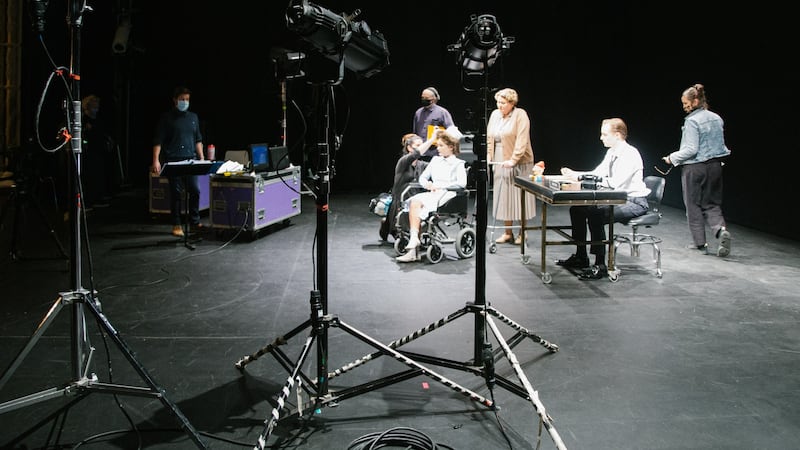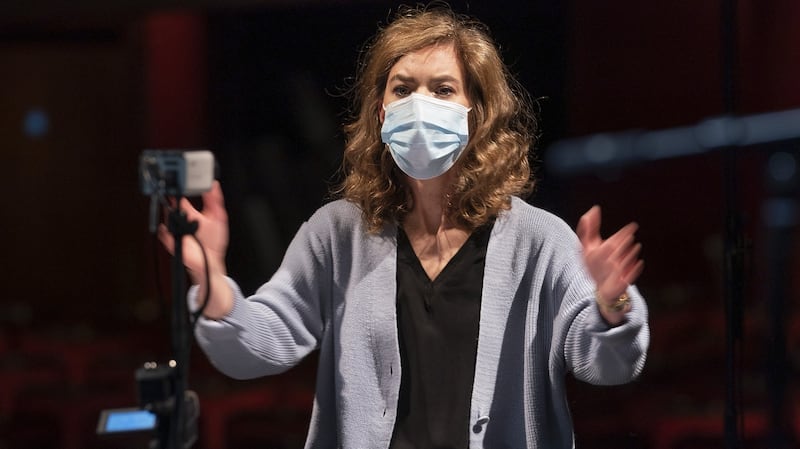“If I wanted to do this I wouldn’t have started from here.” It’s such an obvious point that nobody has actually yet bothered to make it to me about any of the musical activities they have managed to present under the duress of Covid-19. In the case of Irish National Opera, artistic director Fergus Sheil would have to make the rather surreal point that “if I wanted to commission 20 new operas, I wouldn’t have begun with a production of Rossini’s William Tell”.
But the cancellation of the first William Tell production in Ireland since 1877 – originally scheduled for November – was actually the starting point for 20 Shots of Opera.
INO commissioned 20 short operas that were composed, rehearsed and then produced for video in a ridiculously short space of time in the Gaiety Theatre, where William Tell was originally to have returned to the Irish stage. I say ridiculously short because opera planning is usually a matter of years, and INO’s new operas have gone from genesis to finished product in a matter of months. Even though each opera was limited to a maximum of two performers on stage, the list of composers, librettists, singers, directors, designers, video and audio producers, instrumentalists, conductors (working with two ensembles from the RTÉ Concert Orchestra) and stage crew comes to a total of 162 people.
Conductor Elaine Kelly, a member of Irish National Opera's ABL Aviation Opera Studio, shared the conducting duties with Sheil himself. She talks of her delight at having the opportunity to return to working with people in a room, even if the experience did turn out to be unlike anything else she had ever experienced. Her description of how, during rehearsals, everyone had to be socially distanced and wear masks, extends to the moment when she first saw the singers fill their powerful lungs and almost inhale their masks in the process. When it came to the audio recording with the orchestral musicians in the theatre, the distances had to be even greater because everyone had to be so fully shielded from the now unmasked singers.
Kelly conducted nine of the 20 operas, and says that during rehearsals she could hear the work of the project’s other teams working under Fergus Sheil in a nearby space at the Artane School of Music. Gerald Barry’s Mrs Streicher, which is for tenor and tuba and was conducted and directed by the composer, sometimes also featured in the mix.
Normally musicians complain about external sounds that intrude on their work, but in the world of Covid-19 the mere fact of people working nearby seems to have been simply heart-warming. And, of course,here was also the excitement of hearing the unfamiliar new music that was taking shape in the background.
Sessions
Not all of the composers were able to be at the rehearsals, and they were kept in the loop by Zoom, with phone recordings also sent on after the sessions. In spite of the limitations of those recordings, they proved essential to the sessions becoming interactive, with composers sometimes adapting the scores on the basis of the files from the rehearsals.

Yet the final results are anything but what you might expect from filmed opera. Think instead, she says, of opera as film, with the imagery and the general approach considered in the first instance for the camera lens. Social distancing meant that the final videos of everything she conducted had to be mimed – under her supervision – to the pre-recorded soundtrack. The singers were then unmasked but not allowed to sing, so that the cameras could be positioned that bit closer.
Kelly conveys very strongly the stimulation and excitement of dealing with so many works in such a short space of time, and says the experience makes the preparation of a single two- or three-hour opera seem straightforward by comparison. Time in the theatre was tightly controlled, and, with the extravagant distancing, she says she felt she was “50 yards” in front of the singers and musicians. She found it very challenging to find the kind of tight co-ordination that the music demanded and that listeners have come to take for granted.
Sole voice
Soprano Sinéad Campbell Wallace is the sole voice in Andrew Hamilton’s erth upon erth, which INO’s publicity describes as “a response to a terrifying walk through a Covid Hot Zone in a Birmingham hospital in April as seen through the lens of a Medieval English poem”.
Hamilton was actually in hospital at the time, and in rehearsal he encouraged the singer to belt out high notes with heavy vibrato to help replicate the cacophony of ambulance sirens and beeping machines he could hear from his bed. She describes the orchestral writing as creating “a wall of sound” behind her. Her first reaction when she was asked to take part was, “oh my God! Because I had never done anything contemporary.”
She was also concerned about the music being so fresh on the page, and the idea that she would only have a short space of time to learn it “was filling me with dread”.
Fortunately, her husband, the counter-tenor Stephen Wallace, had sung in a number of Hamilton's works with Chamber Choir Ireland, and he told her, "actually, his work is really good! It'll be a good thing to do."
And she was delighted with the collaborative, adaptive way that Hamilton worked with her.
She also mentions the fact that everything was conceived for film, and singles out the close-up of her face with which erth upon erth starts. It's the only one of the operas I've seen in a rough edit, and director Jo Mangan has it opening with an image that brings to mind the famous shot of Buster Keaton's eyelid at the start of Samuel Beckett's Film in Alan Schneider's version of 1965.
For series director Hugh O'Conor – who is also an actor, writer and photographer – the project was a first foray into opera, though he has done a number of music videos. He has directed three of the operas himself, one of which is an animation. As the overseer, he says, "I felt kind of like the mean dean in a John Hughes movie...You've got two-and-a-half hours to do this We've got to do two every day over our 10 days. So that's maximum 10 shots. It's going to take a maximum of 20 minutes per shot. And then you move on. And everybody came back with more shots, saying we need this and we need that. And I just said, No."
His focus was firmly on creating short films rather than "filmed stage pieces", and he sings the praises of the way the members of the core group were able to work together – himself, principal cameraman and editor Hugh Chaloner (if you've watched The Young Offenders, you've seen his work), lighting designer Paul Keogan and designers Sarah Bacon and Katie Davenport. At the end of the day, he says, his first foray into opera has definitely left him with a taste for it.
No hesitation
Composer Conor Linehan had no hesitation when he was contacted about the project. His first reaction was surprise, his second was delight. "I was surprised because I had had only peripheral contact with INO. I said I know who I want to write this with, and I know what I want to do."
He talked to Louis Lovett, who wrote the libretto, telling him, "just do what you can in the time available. You write it. I'll score it. Just crack it on. We'll have no self-censorship whatsoever. It was a process pretty much without difficulty." There was no exact specification, just a duration and a choice of two ensembles, strings with harp and keyboard, or five strings, three brass, three woodwind, percussion and keyboard, "which I thought sounded much more interesting".

The outcome is “a six-and-a-half-minute opera in three acts, a tragicomedy concerning the relationship between a dying woman and her rather callous consultant”. Anyone who’s had “any ongoing things with the consultant class”, he says, “will enjoy it”.
Composer Éna Brennan, who has written “a lot for choral voices, but never for operatic voices”, was “surprised and humbled” to be commissioned. As a musician she has had “toes in so many different rivers”, but she had not imagined herself as registering within the opera scene. Fergus Sheil had explored her work “and wanted to bring that diversity to the palette of 20 composers. Which I was delighted about, especially in the year that’s in it.”
INO provided a document which outlined “the whole project and their intent with it. Fergus wanted for the composers to consider current events without anything being too blatantly about the current events, either.”
She revisited an existing body of work called Rupture with minimal texts, which was commissioned by the experimental vocal ensemble Tonnta. “A lot of the themes are really abstract and existential with a lot of self-doubt. I thought if we need to hold up a mirror to our time, all those themes are incredibly relevant now.”
Productions
Dancer and actor Stephanie Dufresne has worked in two INO productions, Gluck's Orfeo ed Euridice and Brian Irvine and Netia Jones's Least Like the Other. She related to Benedict Schlepper-Connolly's Dust because "it's almost folky. It's contemporary music but not standing and singing with a lot of vibrato. I really connected with the song. The music was so moving."
She describes the piece as “a lamentation for a lack of biodiversity”, a timeless idea that she wanted to ground in the present. She wanted a moving tableau for the singer Michelle O’Rourke, and changed the stage movers’ manadatory masks to full hazmat suits as a high contrast to the romantic tableau. “At the end of the day,” she says, “I was directing a video to support the music rather than vice versa.”
20 Shots of Opera is on www.irishnationalopera.ie from Thursday, December 17th
Elaine Kelly conducts Éna Brennan’s Rupture, Irene Buckley’s Ghost Apples, Linda Buckley’s Glaoch (director Hugh O’Conor), Alex Dowling’s Her Name (director Hugh O’Conor), Jenn Kirby’s Dichotomies of Lockdown, Emma O’Halloran’s The Wait, Hannah Peel’s Close, Benedict Schlepper-Connolly’s Dust (director Stephanie Dufresne), and Jennifer Walshe’s Libris Solar.
Series director Hugh O’Conor also directs Robert Coleman’s The Colour Green.
Conor Linehan's The Patient Woman is directed by Muireann Ahern and Louis Lovett.
Sinéad Campbell Wallace is the sole character in Andrew Hamilton’s erth upon erth, directed by Jo Mangan.
The series' other operas are by Gerald Barry, David Coonan, Peter Fahey, Michael Gallen, Conor Mitchell, Gráinne Mulvey, Karen Power and Evangelia Rigaki.












